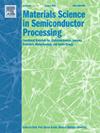钽氧化物电阻式随机存取存储器开关层反应溅射过程中氧分压影响的研究
IF 4.2
3区 工程技术
Q2 ENGINEERING, ELECTRICAL & ELECTRONIC
引用次数: 0
摘要
电阻式随机存取存储器(ReRAM)是一种新型非易失性存储器技术,其潜在应用范围包括各种非冯诺依曼计算架构中的高密度存储器和嵌入式存储器。本研究调查了 ReRAM 开关参数对氧化钽开关层化学计量的依赖性。器件采用反应溅射法制造,在沉积开关层时改变氧分压。利用 X 射线光电子能谱来评估所产生的氧化钽薄膜成分,结果表明,在反应溅射过程中,每种氧分压都会产生不同的 Ta 亚氧化物。电学特性分析表明,在 0.14 mTorr pO2 条件下沉积的 ReRAM 器件具有最佳的器件性能,形成电压低于 3 V,存储窗口为 10。而在较低 pO2 和过高 pO2 条件下制造的器件则无法表现出电阻开关行为。本文章由计算机程序翻译,如有差异,请以英文原文为准。
Investigation of the effect of oxygen partial pressure during reactive sputtering of tantalum oxide resistive random access memory switching layer
Resistive Random Access Memory (ReRAM) is a novel non-volatile memory technology, with potential applications spanning high-density memory and embedded memory in various non-von Neumann computing architectures. This study investigated the dependency of ReRAM switching parameters on the stoichiometry of the tantalum oxide switching layer. Devices were fabricated using reactive sputtering where oxygen partial pressure was varied during deposition of the switching layer. X-ray photoelectron spectroscopy was employed to evaluate the resulting tantalum oxide film composition, showing distinct Ta sub-oxides for each oxygen partial pressure implemented during reactive sputtering. Electrical characterization revealed optimal device performance, with sub-3 V forming voltage and memory window >10 for ReRAM devices deposited with 0.14 mTorr pO2. Devices fabricated at lower pO2 and excessively high pO2 failed to exhibit resistive switching behavior.
求助全文
通过发布文献求助,成功后即可免费获取论文全文。
去求助
来源期刊

Materials Science in Semiconductor Processing
工程技术-材料科学:综合
CiteScore
8.00
自引率
4.90%
发文量
780
审稿时长
42 days
期刊介绍:
Materials Science in Semiconductor Processing provides a unique forum for the discussion of novel processing, applications and theoretical studies of functional materials and devices for (opto)electronics, sensors, detectors, biotechnology and green energy.
Each issue will aim to provide a snapshot of current insights, new achievements, breakthroughs and future trends in such diverse fields as microelectronics, energy conversion and storage, communications, biotechnology, (photo)catalysis, nano- and thin-film technology, hybrid and composite materials, chemical processing, vapor-phase deposition, device fabrication, and modelling, which are the backbone of advanced semiconductor processing and applications.
Coverage will include: advanced lithography for submicron devices; etching and related topics; ion implantation; damage evolution and related issues; plasma and thermal CVD; rapid thermal processing; advanced metallization and interconnect schemes; thin dielectric layers, oxidation; sol-gel processing; chemical bath and (electro)chemical deposition; compound semiconductor processing; new non-oxide materials and their applications; (macro)molecular and hybrid materials; molecular dynamics, ab-initio methods, Monte Carlo, etc.; new materials and processes for discrete and integrated circuits; magnetic materials and spintronics; heterostructures and quantum devices; engineering of the electrical and optical properties of semiconductors; crystal growth mechanisms; reliability, defect density, intrinsic impurities and defects.
 求助内容:
求助内容: 应助结果提醒方式:
应助结果提醒方式:


